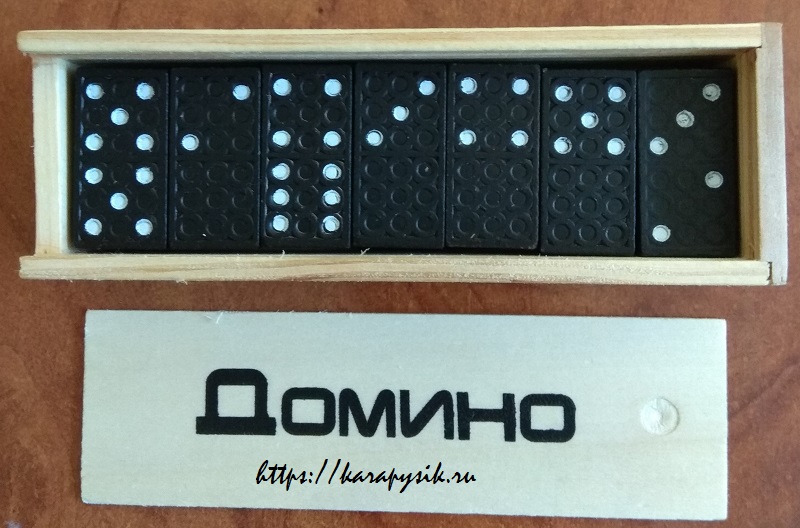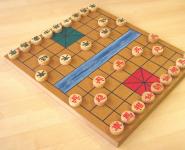How to play dominoes? Domino rules "Goat
Yesterday my son was presented with a domino, but for some reason there were no instructions and rules of the game in it. I had to search the Internet and figure it out myself.
It turns out that the goat version of the domino game is the most popular. It can even be called a domino classic. This option attracts players with its simple rules and causes positive emotions. It is especially interesting to play if 4 people are going.
Let's try together to learn the rules of the goat domino game.
Kit complete set
The game set includes 28 unique dice:
0-0, 0-1, 0-2, 0-3, 0-4, 0-5, 0-6
1-1, 1-2, 1-3, 1-4, 1-5, 1-6
2-2, 2-3, 2-4, 2-5, 2-6
3-3, 3-4, 3-5, 3-6
4-4, 4-5, 4-6
5-5, 5-6
6-6
Dice with the same value on both halves (0-0, 1-1, 2-2, 3-3, 4-4, 5-5, 6-6) are called doubles.
The game can be played by two to four people.
The essence of the game of dominoes "Goat"
The game uses the set of dice described above with a certain number of marked points. The lowest value on the bones is 0, the highest is 6. Each bone has two values.
In the process of laying out the Goat dominoes, the participants place the dice on the table so that the number of dots on one side coincides with the value of the number of dots on the dice already laid out on the table.
The player who first gets rid of all the tiles belonging to him wins.
How to play Goat dominoes?
The game of "Goat" is divided into several stages. At the beginning of each of them, the players blindly take seven dice in their hands.
If a player hits five or more doubles or six or more dice with a repeating value, the dice are pulled.
If less than four people take part in the game, then the extra, remaining dice "open" are moved to the edge of the table, they are called "bazaar". It is addressed if there is no bone on the hands with the required numerical value to make a move.
Game progress
The first move belongs to the player who has a 1-1 double. If no one has such a double in their hands, then the one of the participants who has a double of 2-2 moves. And so on until bone 6-6. If none of the participants has a 6-6 dice, then the first move with a double is 0-0. If there are no duplicates at all, then we move from the dice with the lowest total of points: 0-1, 0-2, etc.
The move is passed clockwise. The next player in the circle must put a dice with the 1st dot on one side, for example 1-3 (provided that the first dice was put on the table 1-1).
That is, each next player must put a dice, the value of which is equal to the value of the dice already laid out on the table on the contact side.

If the player does not have suitable dice, he “goes to the bazaar” and blindly draws one of the extra dice he has put aside. This continues until the player finds a bone with the required value. In one move, you can take an unlimited number of bones from the bazaar until they run out.
If there is no "bazaar" or it is over, and not a single dice has come up, the player skips a move. All the bones taken at the "bazaar" remain in his hands.
A player has no right to skip a turn if he has a dice on his hand that he can play.
A player can put only one die at a time.
The first stage of the game ends when any of the players have no bones left in their hands, that is, the player "left", or when the player bets a "fish". Then the first move at the next stage is made by the “exited” player, or the “fisherman”, that is, the one who placed the “fish”. He can walk from any bone.
A “fish” is a situation in which all players have dice on their hands but are unable to walk. A similar situation is possible when all six (not counting a double) dice with the same value on one side are laid out on the table and both ends of the chain close the dice with the same value.
For example, dice 0-2, 1-2, 2-6, 2-3 are already laid out on the table. The chain ends with a 5-2 bone on one side, and a 2-4 bone on the other. This is a fish".

Scoring
If the first stage of the game ends with a “fish”, the player with the highest total of points in his hand will add all the points of the other players.
In general, the winner of the game is the one who first puts all his chips on the table. To the losers - who have bones left on their hands.
If the next stage of the game ends not with a “fish”, but simply with the “exit” of one of the participants, who got rid of all his dice, then the remaining players open their dice and count the sum of the points of these dice.
If a player has one single 0-0 dice in his hand, then it is considered 10 points. All other dice are considered at par.
If the total of the player's dice does not exceed 12 points, then this number is "remembered" for the next stage of the game. If at the next stage the player collects an amount of 12 or less points again, then the new amount is added to the old "memorized" amount and goes to the "memorized" amount for the next step. If the player “left”, then all his “memorized” points are reset to zero.
If the player scored more than 12 points in the game, then he opened his account in the game. If the player had "memorized" points at the time of opening the account, then they are added to the accumulated amount. From the moment the account is opened, the points are not "remembered" and any, even the smallest, number of points scored in one game will immediately be added to the player's account.
The game is considered over as soon as one of the players scores 101 or more points. A player who scored 101 or more points in total according to the results of the games played is considered a loser, that is, he becomes a "goat".


